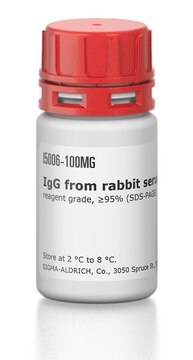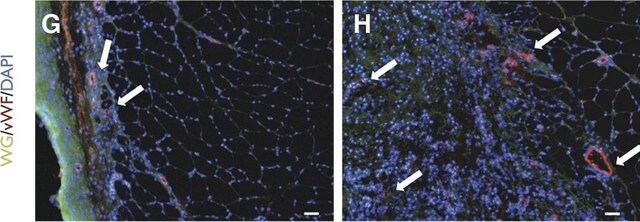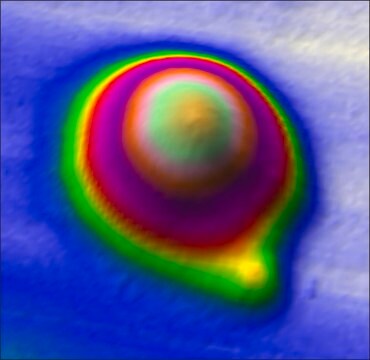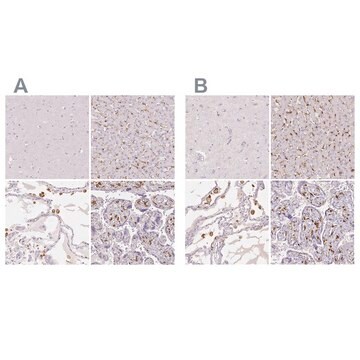AC146
Normal Chicken IgY Antibody, purified | AC146
1 mg/mL, Chemicon®
Anmeldenzur Ansicht organisationsspezifischer und vertraglich vereinbarter Preise
Alle Fotos(2)
About This Item
UNSPSC-Code:
12352203
eCl@ss:
32160702
NACRES:
NA.41
Empfohlene Produkte
Biologische Quelle
chicken
Qualitätsniveau
Antikörperform
purified antibody
Klon
polyclonal
Hersteller/Markenname
Chemicon®
Konzentration
1 mg/mL
Methode(n)
blocking: suitable (interfering antibodies)
Isotyp
IgY
Versandbedingung
wet ice
Posttranslationale Modifikation Target
unmodified
Allgemeine Beschreibung
Chickens transfer high quantities of IgY (IgG) into the egg yolk and harvesting antibodies from eggs eliminates the need for the invasive bleeding procedure. One week′s eggs can contain 10 times more antibodies than the volume of rabbit blood obtained from one weekly bleeding. However, there are some disadvantages when using certain chicken derived antibodies in immunoassays. Chicken IgY does not fix mammalian complement component C1 and it does not perform as a precipitating antibody using standard solutions.
Anwendung
Research Category
Sekundär- & Kontrollantikörper
Sekundär- & Kontrollantikörper
Research Sub Category
Isotypspezifische Kontrollantikörper
Isotypspezifische Kontrollantikörper
Gel Electrophoresis Analysis: 20 µg of reduced Chicken IgY from a representative lot was resolved by SDS-PAGE and visualized using total protein stain.
Note: To be used as a negative control for ChIP Ab+ MeCP2, Cat. No. 17-10491.
Note: For use as a negative control, perform experiments in parallel using primary antibody or normal serum at the same concentration. A signal obtained with the normal serum indicates a nonspecific interaction; any additional signal with the primary antibody indicates a specific antibody-antigen interaction.
Note: To be used as a negative control for ChIP Ab+ MeCP2, Cat. No. 17-10491.
Note: For use as a negative control, perform experiments in parallel using primary antibody or normal serum at the same concentration. A signal obtained with the normal serum indicates a nonspecific interaction; any additional signal with the primary antibody indicates a specific antibody-antigen interaction.
Qualität
Evaluated by Western Blotting using non-reduced Chicken IgY.
Western Blotting Analysis: 0.01 µg of this non-reduced Chicken IgY was detected by a Rabbit anti-Chicken secondary antibody.
Western Blotting Analysis: 0.01 µg of this non-reduced Chicken IgY was detected by a Rabbit anti-Chicken secondary antibody.
Zielbeschreibung
~180 kDa observed. Uncharacterized band(s) may be observed in some cell lysates.
Physikalische Form
T-gel
Format: Purified
Purified chicken polyclonal in buffer containing PBS with 0.05% sodium azide.
Lagerung und Haltbarkeit
Stable for 1 year at 2-8°C from date of receipt.
Rechtliche Hinweise
CHEMICON is a registered trademark of Merck KGaA, Darmstadt, Germany
Haftungsausschluss
Unless otherwise stated in our catalog or other company documentation accompanying the product(s), our products are intended for research use only and are not to be used for any other purpose, which includes but is not limited to, unauthorized commercial uses, in vitro diagnostic uses, ex vivo or in vivo therapeutic uses or any type of consumption or application to humans or animals.
Lagerklassenschlüssel
10 - Combustible liquids
WGK
WGK 2
Flammpunkt (°F)
Not applicable
Flammpunkt (°C)
Not applicable
Analysenzertifikate (COA)
Suchen Sie nach Analysenzertifikate (COA), indem Sie die Lot-/Chargennummer des Produkts eingeben. Lot- und Chargennummern sind auf dem Produktetikett hinter den Wörtern ‘Lot’ oder ‘Batch’ (Lot oder Charge) zu finden.
Besitzen Sie dieses Produkt bereits?
In der Dokumentenbibliothek finden Sie die Dokumentation zu den Produkten, die Sie kürzlich erworben haben.
Emile Rage et al.
Applied microbiology and biotechnology, 103(18), 7491-7504 (2019-07-25)
Infectious bursal disease virus (IBDV) is the cause of an economically important highly contagious disease of poultry, and vaccines are regarded as the most beneficial interventions for its prevention. In this study, plants were used to produce a recombinant chimeric
Nealia Cm House et al.
eLife, 8 (2019-12-06)
CAG/CTG trinuncleotide repeats are fragile sequences that when expanded form DNA secondary structures and cause human disease. We evaluated CAG/CTG repeat stability and repair outcomes in histone H2 mutants in S. cerevisiae. Although the two copies of H2A are nearly
Unser Team von Wissenschaftlern verfügt über Erfahrung in allen Forschungsbereichen einschließlich Life Science, Materialwissenschaften, chemischer Synthese, Chromatographie, Analytik und vielen mehr..
Setzen Sie sich mit dem technischen Dienst in Verbindung.





